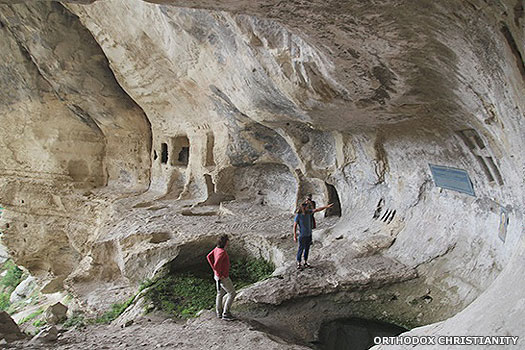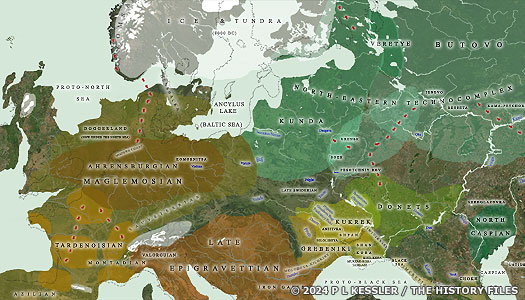 |
|
| (Information by Peter Kessler, with additional information by ChatGPT 3.5 (dates and base notes only), from The Magdalenian Settlement of Europe, Quaternary International Volumes 272-273 (2012), from Radiocarbon Chronology of the Final Palaeolithic, Mesolithic and Neolithic of Crimea, A A Yanevich (Vita Antiqua 11, 2019, Archaeology, Museum & Monument Studies: educational and research aspects), and from External Links: Mesolithic Settlements of the Ukrainian Steppes: migration as sociocultural response to a changing world, Olena Smyntyna (British Archaeological Reports, International Series, 2456, 93-98, January 2013, and available via ResearchGate), and Mesolithic Period (Science Direct), and Early Mesolithic (Indo-European.eu), and Late glacial and Holocene vegetational and climate changes, Natalia P Gerasimenko (Lead Author, Quaternary International Volume 632, 20 September 2022, available via Science Direct).) |
|
| c.10,000 BC |
Crimea is quickly becoming a patchwork of co-existing cultures. Some emerge on plains Crimea, such as the Kukrek and Olexiivka, while others are focussed on mountain Crimea of the south, including the Shan Koba, the newly-emergent Tash-Air, and a latecomer in the Murzak-Koba. The Kizil-Koba (I) culture soon emerges in the foothills of eastern Crimea.  The cave town of Kachi-Kalyon is a huge rocky area with three natural grottos and with clefts which run across it to form a cross on the bow of this gigantic ship-shaped opening, beneath the huge natural canopy called Tash-Air The cave town of Kachi-Kalyon is a huge rocky area with three natural grottos and with clefts which run across it to form a cross on the bow of this gigantic ship-shaped opening, beneath the huge natural canopy called Tash-Air |
| c.9000 BC |
Groups from the early Maglemosian culture eventually intrude into areas of Poland to rediscover abandoned Swiderian resources. Swiderian hunters also enter the Ukraine of the Molodova-Kichkine and Shpan cultures, and also the Crimea of the Shan Koba culture in their search for game. |
| c.8000 - 7100 BC |
The Preboreal period sees the climate become significantly warmer (notably in the Baltics). Birch and pine forests start to spread, and elk, bears, beavers, and various species of water birds migrate into the region from the south. The Tsarinka-Rogalik tradition or culture emerges in the early Mesolithic period (potentially as part of the Shan Koba), although no direct dates are currently available. The Dryas III-Preboreal period in this region above the Black Sea is characterised by aridisation - a general drying out and a resultant decrease in plant life.  Although culturally and technologically continuous with Palaeolithic cultures, Mesolithic cultures quickly developed diverse local adaptations for special environments, as this map shows (click or tap on map to view full sized) Although culturally and technologically continuous with Palaeolithic cultures, Mesolithic cultures quickly developed diverse local adaptations for special environments, as this map shows (click or tap on map to view full sized) |
| Human groups in the centre of this region, part of the Anetivka late Palaeolithic flint-knapping technology, have been broken up by the changes, forced to disperse to more habitable locations which may also include Shan Koba and Tash-Air territories in Crimea. |
|
| c.5000 BC |
The Tash-Air type site in Crimea exhibits its last influences around now, suggesting that it has most definitively now been succeeded by the Kukrek culture. In nearby Eastern Europe the relatively unknown Bilolissya has already long since faded, while the Tsarinka-Rogalik may only just have turned into the widely-dominant Grebeniki culture. |
 |
|
 Archaeological finds are constantly being made, and archaeological cultures are frequently being updated with new information. Get in touch here if this page also requires updating.
Archaeological finds are constantly being made, and archaeological cultures are frequently being updated with new information. Get in touch here if this page also requires updating.
 The cave town of Kachi-Kalyon is a huge rocky area with three natural grottos and with clefts which run across it to form a cross on the bow of this gigantic ship-shaped opening, beneath the huge natural canopy called Tash-Air
The cave town of Kachi-Kalyon is a huge rocky area with three natural grottos and with clefts which run across it to form a cross on the bow of this gigantic ship-shaped opening, beneath the huge natural canopy called Tash-Air Although culturally and technologically continuous with Palaeolithic cultures, Mesolithic cultures quickly developed diverse local adaptations for special environments, as this map shows (click or tap on map to view full sized)
Although culturally and technologically continuous with Palaeolithic cultures, Mesolithic cultures quickly developed diverse local adaptations for special environments, as this map shows (click or tap on map to view full sized)